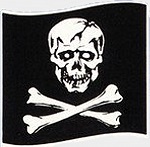Forces of Valor FOV812020A USMC Chance-Vought F4U-1D Corsair Fighter - Lt. Ira Kepford, VF-17 "Jolly Rogers", 1944 (1:72 Scale)
"Why should we have a navy at all? There are no enemies for it to fight except apparently the Army Air Force."
- General Carl Spaatz, Commander of the US 8th Army Air Force, after WWII
 The Vought F4U Corsair is an American fighter aircraft which saw service primarily in World War II and the Korean War. Designed and initially manufactured by Chance Vought, the Corsair was soon in great demand; additional production contracts were given to Goodyear, whose Corsairs were designated FG, and Brewster, designated F3A.
The Vought F4U Corsair is an American fighter aircraft which saw service primarily in World War II and the Korean War. Designed and initially manufactured by Chance Vought, the Corsair was soon in great demand; additional production contracts were given to Goodyear, whose Corsairs were designated FG, and Brewster, designated F3A.
The Corsair was designed and operated as a carrier-based aircraft, and entered service in large numbers with the U.S. Navy in late 1944 and early 1945. It quickly became one of the most capable carrier-based fighter-bombers of World War II. Some Japanese pilots regarded it as the most formidable American fighter of World War II and its naval aviators achieved an 11:1 kill ratio. Early problems with carrier landings and logistics led to it being eclipsed as the dominant carrier-based fighter by the Grumman F6F Hellcat, powered by the same Double Wasp engine first flown on the Corsair's initial prototype in 1940. Instead, the Corsair's early deployment was to land-based squadrons of the U.S. Marine Corps and U.S. Navy.
The Corsair served almost exclusively as a fighter-bomber throughout the Korean War and during the French colonial wars in Indochina and Algeria. In addition to its use by the U.S. and British, the Corsair was also used by the Royal New Zealand Air Force, French Naval Aviation, and other air forces until the 1960s.
From the first prototype delivery to the U.S. Navy in 1940, to final delivery in 1953 to the French, 12,571 F4U Corsairs were manufactured in 16 separate models. Its 1942-1953 production run was the longest of any U.S. piston-engined fighter.
Pictured here is a 1:72 scale replica of a USMC Chance-Vought F4U-1D Corsair fighter that was piloted by Lt. Ira Kepford, who was attached to VF-17 "Jolly Rogers", then embarked upon the USS Bunker Hill (CV-17) during 1944.
Sold Out!
Dimensions:
Wingspan: 7-inches
Length: 6-inches
Release Date: August 2021
 Historical Account: "Zekes" - In the Battle of the Solomon Sea, Ira Kepford pressed through blistering AAA fire from the Bunker Hill to down four enemy aircraft and damage a fifth, for which he was awarded the Navy Cross. On January 29th, Kepford led his wingman in an attack on 12 Japanese fighters over Rabaul; he scored four kills, and was awarded a Gold Star, for this action.
Historical Account: "Zekes" - In the Battle of the Solomon Sea, Ira Kepford pressed through blistering AAA fire from the Bunker Hill to down four enemy aircraft and damage a fifth, for which he was awarded the Navy Cross. On January 29th, Kepford led his wingman in an attack on 12 Japanese fighters over Rabaul; he scored four kills, and was awarded a Gold Star, for this action.
While returning to base on February 19th, 1944, Kepford spotted a low Japanese seaplane. Although he was alone (his wingman was forced to abort earlier, and Kepford was retained to cover bombers on-route to Rabaul), Kepford dived down and flamed the plane. He was then attacked by a flight of three Zekes, which dived onto him with a massive altitude advantage. Kepford took full advantage of the newly-installed water injection WEP to stretch out the chase, but the Zekes' energy advantage allowed them to slowly narrow the gap. As the lead Zeke opened fire, Kepford decided to "go for broke." He dropped his flaps and landing gear and nosed down until he was skimming the waves; as the Zeke roared over him, he pulled his Hog's nose up and opened fire. The Zeke's stabilizer crumpled under the snapshot, and the plane crashed into the waves. As Kepford pulled in his gear and flaps, the remaining two Zekes bracketed him . . . he was facing 2-to-1 odds, low and slow, and he was heading back in the direction of Rabaul. Kepford ran his throttle as far open as possible, and after gaining some speed he cut across the path of the port Zeke. The Japanese plane dropped to wave top level, opened fire, and sharply turned to fall onto his six . . . at which point the Zeke's left wing caught a wave top, and the plane cartwheeled across the ocean surface, disintegrated, and sank. The third Zeke was left behind as Kepford dashed for home, landing on fumes in his fuel tank.


